Tell Me About the Daedra Again
![]()
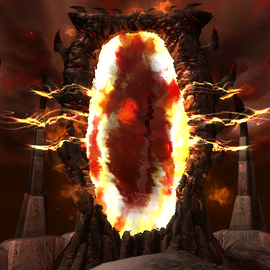
A gate to Oblivion.
- "Daedra were born before the stars, mortal. Do you consider that perhaps such names preceded, hence perhaps inspired, the concepts they connote?"
- ―N'Gasta[src]
Daedra (singular: Daedroth)[1] is the term for the entities who inhabit the realms of Oblivion in The Elder Scrolls. They are viewed variously equally gods or demons by the inhabitants of Tamriel, although scholarly consensus discourages the utilize of the latter term.[1] The most powerful of the Daedra are referred to as Daedric Princes or Daedra Lords,[2] and dominion over their ain planes of Oblivion, which they shaped.[iii] Because they take no connection to Nirn, they cannot be permanently killed, just banished.[4]
Daedra tin be summoned to Nirn through a variety of techniques,[5] which forms the basis for much of the school of Conjuration magic.[6]
Diverse Daedra have, on several occasions, attempted to invade Nirn. The nigh infamous events of this type are the Planemeld and the Oblivion Crisis.
Contents
- 1 Lore
- i.ane Etymology
- 1.ii Origins
- 1.3 Aboriginal history
- ii Classification of Daedra
- 2.ane Daedric princes
- two.two Lesser Daedra
- ii.2.1 Humanoids
- 2.ii.two Reptilians
- ii.2.three Atronachs
- 2.2.4 Others
- 2.2.v Daedric artifacts
- three Appearance and invocation
- 4 Characteristics and behavior
- 4.1 Daedric alphabet
- five Daedra worship
- 5.1 Daedra cults
- 5.ii The Dunmer
- 5.2.ane Chimeri Daedra worship
- 5.ii.2 The Anticipations and the Firm of Troubles
- 5.two.3 The Reclamations
- 5.3 The Khajiit
- v.4 The Orcs
- 5.5 The Ayleids
- 6 Daggerfall Description
- 7 Trivia
- 8 Appearances
- 9 External links
- 10 References
Lore [ ]
Etymology [ ]
The term "Daedra" is of merish origin. Its literal translation is "not our ancestors," as opposed to Aedra - "our ancestors."[4] This harks back to their refusal to take part in the creation of Mundus, and equally a effect are non part of the Ehlnofey, the ancestors of men and mer.[7]
The term "Daedra" tin exist used for both plural and singular forms, although the latter is more correctly "Daedroth,"[ane] not to exist confused with the species of bottom Daedra that become by the same name.
Origins [ ]
Several different religions and cultures explain the Daedra and their Princes in different means, making the distinction difficult to properly ascertain, especially due to certain Daedra discrediting some explanations.
In many cultures, Daedra are considered to exist "Padomaic" beings, as described in The Annotated Anuad, which claims that the Daedra were formed of the blood of Padomay, prior to the creation of Nirn.[seven] This is contradicted past the fact that Meridia, a Daedric Prince, was once Merid-Nunda, one of the Magna Ge[8] (including Magnus) that withdrew from the world every bit it was being created. Since these beings were considered "Anuic" beings in the aforementioned myth, it would mean that Meridia was formed of the blood of Anu instead of Padomay, despite existence classified every bit a Daedric Prince.
Other accounts depict the Daedric Princes as those et'Ada who, when Lorkhan proposed the creation of Nirn, outright refused to take role.[three] Malacath's very existence discredits this, as he was once Trinimac, i of the Aedra, who was corrupted by Boethiah (this process is often said to consist of his literal consumption and eventual excretion past Boethiah).[nine]
In both cases, however, the conversion of Merid-Nunda and Trinimac into Daedric Princes are both the result of the influence of other Daedra, with the former beingness "bandage down" after consorting with them, and the latter changed by one in some fundamental manner. It should exist noted, however, that it is said Malacath is not considered a true Daedra Lord past his peers, who despise him.[9]
The Monomyth provides a slightly clearer definition, stating that the Daedra and the Daedric Princes are all members of the et'Ada that formed with closer ties to Oblivion, stated to exist closer to the Void from which they reincarnate new forms upon their deaths,[3] which could account for Meridia'southward afterwards reclassification.
Lesser Daedric entities were mostly created past the Princes,[3] simply the Spirit of the Daedra implies that a few types were formed naturally, which may account for the Daedra that do non claim loyalty to any particular Prince, such as the Atronachs.[5] The Monomyth states that the Daedra consisted of both "spirits and Gods," farther implying that some Lesser Daedra were formed alongside the Princes.
Ancient history [ ]
When Lorkhan proposed to the et'Ada the creation of the mortal plane, Mundus, the Daedric Princes felt it foolish to cede and so much power unto a world, and chose instead to create worlds of their ain.[iii] These "Daedric Realms," created in the chaos of Oblivion, used their own essences to create them, but did non cut that power and affair off from themselves as the Aedra did, allowing them to retain full power and maintain total command over their worlds.
Lesser Daedra created past the Princes served every bit servants and worshippers, and often as playthings, and the Daedra Lords were content and mostly happy with their realms. Finding the activities of Mundus' mortal races to be far more piquing, the Daedra began to meddle with mortal life, seducing the nigh promising individuals to spite the Aedra.
Classification of Daedra [ ]
Daedra appear in many dissimilar forms. The most of import are the Daedric Princes, among the oldest and most powerful of their kind. The rest are the "Lesser Daedra," beings who inhabit Oblivion and may or may not be in league with these greater powers.
Daedric princes [ ]
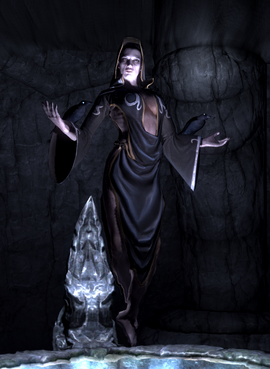
Nocturnal.
- Main article: Daedric Princes
In that location are considered to be either 16 or 17 Daedric Princes, although records on this vary.[ane] Each Daedric prince has a concept or set of concepts associated with them, termed their "sphere." Note that this does non necessarily mean that each Daedra has control over their sphere; rather, they are their particular areas of concern or interest.
Not all of the Princes were ever so. Malacath was one time Trinimac, champion of Auri-El, simply became Malacath after being eaten by Boethiah when he tried to cease the Chimer from leaving Summerset Isle.[ix] Meridia was in one case counted among the Magna Ge, only became a Daedric Prince when she bent the lite of Magnus through herself, carving out her own realm of Oblivion in the procedure.[viii]
A list of nigh of the Daedric Princes, their titles, realms, and spheres are listed below:
| Daedra Prince | Other nomenclature | Sphere | Airplane of Oblivion |
|---|---|---|---|
| Azura, Azurah[10] | Mother of the Roses,[11] Mother Soul,[12] Queen of Sunset and Dawn,[xiii] Queen of the Nighttime Sky[11] | Twilight, Prophecy | Moonshadow[13] |
| Boethiah | Father of Plots,[5] Prince of Plots,[14] [15] Fount of Inspiration,[sixteen] Deceiver of Nations,[xv] Queen of Shadows,[fifteen] Goddess of Devastation,[15] He-Who-Destroys,[fifteen] She-Who-Erases [15] | Conspiracy, Deceit, Unlawful overthrow of authority[xi] | Attribution's Share/Ophidian Mount[UL 1] |
| Clavicus Vile | Child-god of the Morningstar[UL i], Master of Insidious Wishes[xiv] | The granting of ability through pacts and wishes[11] | The Fields of Regret |
| Hermaeus Mora, Hormaius[1], Hermorah[17],Herma-Mora[3] | Abyssal Cephaliarch,[eighteen] Demon of Noesis,[xix] The Golden Eye,[20] The Inevitable Knower,[21] Onetime Antecedent,[21] Woodland Homo,[19], The Gardener of Men[22], Wretched Abyss[23], Keeper of Forbidden Noesis[14] | Fate,[11] Cognition,[24] Learning,[24] Memory[xi] | Apocrypha[13] |
| Hircine | Huntsman of Princes,[i] Father of Human being-Beasts,[i] Lord of the Hunt[14], The Hungry Cat (Khajiit nonclementure) | The Hunt[11] | The Hunting Grounds[25] |
| Jyggalag | Lord of Order[1] | Social club | Shivering Isles/None |
| Malacath, Mauloch[iii] | Creator of Curses[fourteen], Principal of Curses, Keeper of Oaths[26] | The Spurned, the Sworn Adjuration, the Encarmine Expletive[11] | Ashpit[13] |
| Mehrunes Dagon | Lord of Razors,[UL 1] Prince of Devastation[14] | Destruction, Revolution, Change | Deadlands[13] |
| Mephala | Webspinner[14], Spinner, Spider[eleven] | Lies, Sex,[27] Secret murder[27] | Spiral Skein |
| Meridia, Merid-Nunda[8] | The Glister-Witch,[28] Lady of Space Energies,[29] Lady of Light[xxx] [14] | Living things[11] | The Colored Rooms[8] |
| Molag Bal | Male monarch of Rape,[13] Father of Vampires[31], God of Schemes, Father of Coldharbour, Harvester of Souls, Schemer Prince, Lord of Abuse[fourteen] | Domination, Enslavement[eleven] | Coldharbour [13] |
| Namira, Namiira[10] | The Spirit Daedra,[xi] the Keen Darkness,[10] Lady of Decay[xiv] | The Aboriginal Darkness,[xi] All things repulsive[32] | The Scuttling Void[UL ane] |
| Nocturnal | Night Mistress,[11] the Ur-dra,[UL i] Queen of Murk, Empress of Shadow, Mistress of Shadows[14], Lady Luck | Night, Darkness[11] | Evergloam |
| Peryite | The Taskmaster,[11] Bringer of Disease and Pestilence[33] [fourteen] | Ordering of the lowest orders of Oblivion,[11] Pestilence[1] | The Pits |
| Sanguine | Lord of Revelry[14] | Hedonism, Immoderacy, Indulgence[eleven] | Myriad Realms of Revelry[34] |
| Sheogorath | The Mad God, Lord of the Never-There,[35] Sovereign of the Shivering Isles,[35] Prince of Madness[36] [14] | Madness[11] | Shivering Isles [35]/ The Madhouse[thirteen] |
| Vaermina | The Gifter,[37] Weaver of Dreams[xiv] | Dreams, Nightmares,[xi] Omens[UL 1] | Quagmire [13] |
Lesser Daedra [ ]
At that place are many types of lesser Daedra, near of which were created past the Princes every bit warriors, servants, playthings, and worshippers. It should exist noted that the descriptions of appearances given here are not necessarily always accurate, as to many Daedra, appearance is a affair of choice. Belonging to a detail grouping is, nonetheless, said to shape their bodies and minds, and thus common traits are established.[38]
Humanoids [ ]
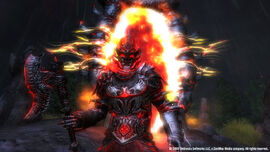
A Dremora as seen in The Elderberry Scrolls Iv: Oblivion
Many Daedra of greater mental capacity accept a humanoid shape and appearance. The Daedric Princes and their servants are usually amid them. Daedra who unremarkably accept a humanoid grade are:
- Dremora – Most of the mod Dremora serve Mehrunes Dagon,[5] although some clans serve Molag Bal and Malacath,[28] and others before Dagon.[38] They are organized into clans with strict hierarchical structures and ranks.[39]
- Gilt Saints – Appear as golden-skinned humans in golden armor,[5] and serve Sheogorath as guards of his realm, in a defined hierarchy.[40] They are said to be Sheogorath's favored soldiers and take a rivalry with the Dark Seducers.[41]
- Dark Seducers – The violet-skinned serving Sheogorath. In the Shivering Isles, they serve every bit Sheogorath'due south guards,[xl] and have an ongoing feud with the Golden Saints for Sheogorath's favor.[41]
- Knights of Club – Crystalline entities resembling armored knights with swords, this race of crystalline warriors are the servants of Jyggalag, with their incapacity for fear making them among the more than unsafe Daedra.
- Aurorans – Mostly serve the Daedric Prince Meridia; they appear as humanoids clad in Ayleid battle armor.
- Xivilai – Highly intelligent creatures who serve Mehrunes Dagon. They are alike in temperament to the Dremora, but are less likely to be subordinate to anything.[39] Xivilai often appear equally bluish-skinned humanoids.
- Xivkyn – Powerful Daedra created by Molag Bal through the fusion of Dremora and Xivilai.[42] They resulted from vestigial hybridization experiments in The Vile Laboratory.
Reptilians [ ]
Daedra accept amongst their ranks some reptilian creatures, outlined below.
- The Daedroth resemble big, bipedal crocodiles, with abrupt claws and teeth, and serve Molag Bal.[5]
- The Clannfear are bipedal reptilian creatures, with a head like a ceratopsid dinosaur. They are loyal to Mehrunes Dagon.[5]
Atronachs [ ]
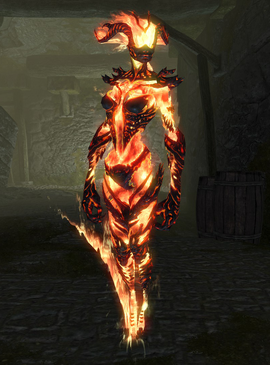
A Flame Atronach
Atronach are Daedra associated with a particular element, substance or natural phenomenon. They are not nominally aligned with whatsoever Prince, and serve them according to opportunity, fancy and circumstance dictate.[5] Their types are:
- Flame Atronach
- Frost Atronach
- Storm Atronach
Although nominally unaligned, these Daedra may accept dwelling planes, equally Flame Atronachs are noted to originate from a plane known every bit "Infernace."[43] The home planes of other atronach are currently unknown. There also exist Flesh Atronachs and Iron Atronachs, which are creations of mortals, and more correctly golems than whatever kind of Daedra.
Others [ ]
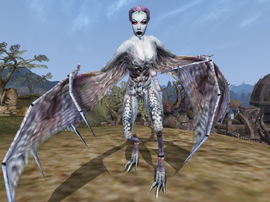
A winged twilight
- Winged Twilight are one of the few known Daedric creatures capable of flying (others including Watchers and Daedric Titans). They carry some resemblance to Harpies, and their skin is a blue color. Their skulls are near the same size equally a homo's, and they also possess large tails. They are servants of Azura.[5]
- Spider Daedra announced equally a kind of spider-centaur, a large spider with a female person human'due south head and torso in identify of the spider'southward caput. They are associated with Mephala, and are and so unruly and irrational that even Mephala's worshippers rarely summon them for fear that they will disobey their orders.[5]
- Ogrim are enormous Daedra with very little intellect, simply which are chiefly sent into the mortal world to menace living things for the amusement of Daedric Princes. Ogrim are associated with Malacath.[v]
- Hunger are powerful and trigger-happy Daedra with great magic power, associated with Boethiah.[5]
- Scamps are small goblin-similar creatures, skittish in nature. They are often associated with Mehrunes Dagon.[5]
- Vermai appear similar to scamps, just are hardier. Featured in Battlespire and Redguard.
- Herne and Morphoid Daedra resemble horned scamps, associated with Mehrunes Dagon and Hircine. Featured in Battlespire.
- Seekers are tentacled Daedra that are native to Apocrypha and are associated with Hermaeus Mora.
- Lurkers are large amphibious Daedra who are native to Apocrypha, guarding the secrets of the Blackness Books, but they have been seen in Tamriel. They are associated with Hermaeus Mora.
Daedric artifacts [ ]
- Main article: Daedric Artifacts
The spirits of Daedra tin be summoned and reshaped into items on a short-term basis, to create jump weapons, or permanently, to create Daedric artifacts.[5] The text is not clear on whether the Daedric Prince who is lord over the spirit creates spring weapons in Oblivion, which is then summoned to Mundus, or whether the summoner reshapes the Daedra in question.
Daedric artifacts tin exist either fabricated by a Daedric Prince, such as the Masque of Clavicus Vile,[25] or infused with the spirit of a Daedra, as with the case of the quill Feyfolken.[44] Still other artifacts go associated with the Daedra over time, despite no known connection to the Daedra, such every bit Volendrung, which was crafted by the Rourken Clan of the Dwemer but later became to be associated with Malacath.[45]
A listing of known Daedric artifacts, their forms and their associations, given hither:
| Artifact Name | Artifact Form | Associated with |
|---|---|---|
| Azura's Star/The Black Star | Soul Gem | Azura[46] |
| Bittercup | Cup | Clavicus Vile |
| Black Books | Books | Hermaeus Mora |
| Bow of Shadows | Bow | Nocturnal[25] |
| Dawnbreaker | Sword | Meridia |
| Ebony Blade | Sword | Mephala |
| Ebony Mail | Cuirass | Boethiah[25] |
| Feyfolken | Quill | Clavicus Vile[47] |
| Goldbrand | Sword | Boethiah |
| Mace of Molag Bal | Mace | Molag Bal[25] |
| Masque of Clavicus Vile | Mask | Clavicus Vile[25] |
| Mehrunes' Razor | Dagger | Mehrunes Dagon[25] |
| Oghma Infinium | Book | Hermaeus Mora[24] |
| Band of Hircine | Ring | Hircine |
| Ring of Khajiit | Ring | Mephala[25] |
| 24 Artifacts of Sanguine | 24 random clothes/rings/belts/amulets | Sanguine |
| Sanguine Rose | Rose, Staff | Sanguine |
| Savior's Hide | Cuirass | Hircine[25] |
| Scourge | Ebony Mace | Malacath |
| Skeleton Key | Key | Nocturnal |
| Skull of Corruption | Staff | Vaermina |
| Spear of Biting Mercy | Spear | Sheogorath[25] |
| Spellbreaker | Shield | Peryite[25] |
| Volendrung | Warhammer/Blade | Malacath[45] |
| Wabbajack | Staff | Sheogorath[24] |
Appearance and invocation [ ]
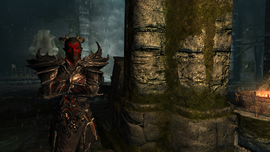
Sanguine.
Daedra can appear on Nirn through summons past both worshippers and conjurers. These tin can be either short-term summons, or rituals/pacts designed to demark the Daedra to Nirn on a more permanent basis.[5] There are claims that this art originated with the Direnni clan in the Starting time Era,[48] but the exodus of the Daedra-worshipping Velothi from Summerset Island in the Merethic Era ways this is in all likelihood fake.[49]
At that place are no definite restrictions on when or where Daedra may be summoned, although certain dates and circumstances either make this easier or are the conventional times that Daedra-worshiping cults exercise and so,[50] and a summoning is less a command and more than an invitation in the instance of more powerful Daedra.[51] Daedra of sufficient ability may also be able to manifest on their own, although this may also be summoned Daedra who accept escaped their bindings.
It was theoretically impossible for both bottom Daedra and Daedric princes to manifest while Alessia'south covenant with Akatosh was in force.[52] However, Daedric summoning has been possible throughout Tamriel's history, indicating this was not the case. The extinguishing of the Dragonfires in 3E 433 did however allow Daedra to manifest Oblivion Gates on Tamriel, assuasive large scale Daedric entrance onto Nirn, and for Daedric Princes to appear unimpeded on Nirn. This was remedied when Martin Septim bankrupt the Amulet of Kings and became the avatar of Akatosh, defeating Mehrunes Dagon and sealing the Oblivion Gates.[53] Withal, pocket-size-calibration Daedric summonings are still possible.
Characteristics and beliefs [ ]
Though all Daedric races have their own characteristics and behavior, there are many traits consistent throughout almost all of them, partially described in Spirit of the Daedra. Firstly the book states that Daedra do non truly fear death or dying, for their "Animus," that conscious essence that could be considered their "spirit," is cast into the Void and reincarnates a new vessel for itself. Due to this, they have no fear of decease, simply they do accept other fears. Many Daedra refer to the Void as the Darkness, and some admit to the shared fear of it that the Daedra have, and they hate it, though the reasons why are unknown.
Daedra are also stated to feel pain, shame, failure, and loss, and then fright all of these things. Daedra of lesser intellect, such as Scamps, have very little capacity for fright, while mindless Daedra like Vermai cannot fear at all. Daedra such as Dremora, Golden Saints, and Dark Seducers, all have college intelligence and the chapters for deep idea, and and so can just master the fears they have to overcome them.
Daedric spirits, whether or not they were created past Princes or existing aslope them, are not biologically related to each other, but shape themselves in accordance to the "clan-form." This powerful forcefulness causes the bodies their spirits incarnate into from the Void, giving class to the idea, and possibly influencing their psychological states. The clan-class is the cause of differentiation, with the clan-class of a race similar the Dremora triggering the reformation of the spirit as a Dremora and the clan-course of the Aurorans causing the reformation as an Auroran. By this reasoning, a Daedra that ends ane life as a Dremora could reform equally an Auroran, and vice versa. Due to the implication of minds being altered, and the Daedric belief that the association-form gives them meaning and strength, such a decision is very unlikely to be made.
Daedra return from the Void through "cynosures," conduits of power that permit the reincarnating Daedroth to return to its realm of residence, and retake its body, shaped in the clan-form. In their fearfulness of the Void, Daedric spirits use the conduits as beacons, to find their way back to their home worlds. Without access to a cynosure, a Daedroth in the Void will simply reside at that place until the cynosure reopens, or a new and uniform one opens for them. Examples of such structures include the Wellsprings of the Aureals and the Mazken, and the obelisks of the Knights of Order. While the deactivation of an obelisk does not affect an incarnated Knight of Order, the sealing of the Wellsprings caused either the Golden Saints or the Nighttime Seducers to instantly die, returning to their bodies when the obstacle was removed. This could be due to the style of the sealing, using the Daedric crystals of Club, or a characteristic that the two of Sheogorath'due south races have, and do not share with the Knights.
No Daedroth is truly bound to a Prince or other powerful main. Instead they seek out who they perceive as the strongest and greatest amid the powerful, by and large so that they tin be protected past a strong master. The Daedric races serve their masters by association tradition, just traditions have been known to change, and i individual Daedroth serving a main dissimilar their race's own is not unheard of. For example, Dremora as a whole have chosen to be in the service of Mehrunes Dagon, but accept non always done and so, and particular groups of Dremora serve other masters instead. Practice is too known to change based on the "oath-bond" between the Prince and its servants, and when this bond is weak, the Lesser Daedra are subjected to their fears.
Most of the Daedra and their Princes have piffling heed for mortals, viewing them as little more toys, and because themselves to be the huntsmen and the mortals every bit casualty. Daedra of bottom intellect are seen every bit hounds and work animals to those of higher intellect. Some consider the gustation of mortals to be pleasant, and to torment them is seen as "diverting," perhaps implying that Daedra toy with mortals as a distraction or to relieve woes and stress.
Despite their callous torment of mortals, Daedra and their Princes have been known to truly admire mortals at certain times, and feel displeasure when they finally fail. Some will secretly, or even openly, give praise those that tin foil their plans and resists their seduction, and even applaud when mortals can find a way to slay them.
They acknowledge the frailty and gradual disuse of mortals, and consider their victories minor things that simply require temporary reconstitution at the worst, though even the risk of that makes their torment of Mundus all the sweeter. Merely the Daedra do sometimes consider mortals a mysterious thing, for they live generally content lives, despite all the horrid things that they feel, such as failure, death, and loss. Virtually, if non all, of the Daedra cannot encompass how mortal races, despite their doom of suffering beingness painfully obvious, are not consumed by despair when the Daedra, who never feel death and cannot truly empathise the concept, despair at failure and pain. Nonetheless, many of the Daedra find this mystery to exist i of the near enticing things about mortals, giving them more cause to meddle in their affairs and take interest in their lives.
Daedric alphabet [ ]
- Main commodity: Daedric Alphabet
The script used in the games is referred to as the "Daedric alphabet." It appears to be nearly frequently used in relation to magical texts (such as spell scrolls as they announced in Morrowind), or esoteric works like the Mysterium Xarxes.
Daedra worship [ ]
Daedra are worshiped in a variety of ways across Tamriel. The almost common of these are detailed below.
Daedra cults [ ]
This is the near common fashion Daedra are worshipped on Tamriel for most of history, because there accept been times where such worship has been prohibited in many provinces, and even when it is legal, such as in Cyrodiil during the Tertiary Era, it is generally non approved of by nigh of society.[51] Still, even if their worship is not condoned, it appears that the commemoration of their feast days by non-adherents on some occasions.[54] These cults typically focus on a single Daedric Prince as their prime number deity,[50] although given the nature of the creation such cults should probably be described as henotheistic or monolatristic, rather than truly monotheistic.
These groups are typically quite pocket-size and inconsequential because of their size and isolation. Even so, in the belatedly 3rd Era, the Mythic Dawn, a Daedra cult dedicated to the worship of Mehrunes Dagon, assassinated Uriel Septim Seven and precipitated the Oblivion Crisis.[53]
The Dunmer [ ]
The Dunmer as a civilization have worshipped the Daedra at various points in their history. This has changed over fourth dimension, and this progression is discussed below.
Chimeri Daedra worship [ ]
The Chimer were led away from Summerset past Veloth and Boethiah, who ate Trinimac to aid their exodus.[12] Boethiah was joined past Azura and Mephala in leading the Chimer to Vvardenfel,[55] and accompanied by Malacath, Mehrunes Dagon, Molag Bal and Sheogorath.[56] Azura, Boethiah and Mephala are credited with bringing a particular course of advocacy to the Chimer, Boethiah in areas as diverse as philosophy to compages, Mephala in devising the House organization that would define later Chimer and Dunmer club, and Azura taught them how to exist different to the Altmer.[55] These are seen as the "Good Daedra" in much Dunmeri folklore. The other four Daedra are traditionally seen as testing and opposing figures,[55] although this may be a later on elaboration originating during the Tribunal period.
The Anticipations and the House of Troubles [ ]
Post-obit the embodiment of the Tribunal, Daedra took a lesser role in firm Dunmeri society, and their worship was prohibited by the Tribunal Temple because it they claimed the Daedra were unworthy due to their inconsistent and dangerous natures.[12] This led to a decline in Daedra worship among the Great Houses, although the Ashlanders carried on worshipping the Daedra as they had always done.[57] Azura, Boethiah and Mephala allegedly consented to be replaced, and became the "Anticipations" of the Tribunal, sharing certain aspects with the Tribunal fellow member who replaced them.[12] Almalexia replaced Boethiah, Sotha Sil replaced Azura, and Vivec took the place of Mephala. The other four Daedra previously worshiped by the Chimer did non accept this nonetheless, condign the 4 Corners of the Business firm of Troubles.[56] Their roles as testing figures and obstacles to be overcome was solidified at this point.
The Reclamations [ ]
Following the events of the Red Yr in 4E five, the Dunmer began to lose faith in the at present missing Tribunal, and schisms broke out inside the Temple. Eventually the Dissident Priests emerged predominant, and re-instituted the worship of the three Expert Daedra, with the Tribunal venerated as saints.[57] As office of this, they were named the Reclamations, and the Ashlanders heralded as the guardians of the truth path of worship.[57]
The Khajiit [ ]
The Khajiit recognize the Daedra every bit one of two "litters" of spirits created by Ahnurr and Fadomai.[ten] The Daedra exercise not differ much from their portrayals in other faiths, but the Khajiit believe that they were created past Azurah out of a unmarried line of "forest people," some of whom were later on corrupted by Y'ffer to go the Bosmer.[x]
The Orcs [ ]
The orcs are derived from the changed followers of Trinimac, later on he was turned into Malacath past Boethiah.[9] Orcs typically follow their changed god exclusively, and his laws form the Code of Malacath, which lay down the basic rules for orc gild.[58] This was only different in Gortwog's Orsinium, where some orcs worship Trinimac in his original form, considering Malacath a demon and an imposter, much to the displeasure of orcs elsewhere.[59]
The Ayleids [ ]
The now-extinct Ayleids of Cyrodiil worshipped the Daedra alongside the Aedra, forming a diversity of cults to worship many Princes.[60] [61] However, they seem to hold Meridia in particular reverence due to her association with light, which the Ayleids considered ane of the prime number elements of creation.[8] Some claim that they revered Meridia above all other gods.[62]
Daggerfall Description [ ]
Within the Daggerfall Chronicles, Daedra take been given a description.
- "The peastants accept colorful terms for Daedra: fiends, unclean spirits, the evil ones, the Night Princes, the gods of torment, the infernal ones, and, most usually, demons. Those who wish to understand or battle these nightmarish beings, rather than live in fear, adopt the more attentive term, Daedra. Information technology is nearly impossible to say anything definitive virtually Daedra, despite thousands of years of scholarship devoted to their nature. Their reputation as fell, amoral geniuses of destruction seems to be generally deserved, just if they are true evil, our definition of evil may need revision to include the complexity of their natures. Daedra announced to have a well-organized bureaucracy, and the ones constitute in our earth are doubtless the weakest of the lot. Of class, the Burn Daedra, the Frost Daedra, the Seducer, or the Daedra Lord are among the msot dangerous creatures in Tamriel, just in that location is certainly something greater out there in the world they call Oblivion. Perhaps we are already doomed to autumn below their burn."
- ―Daedra description[src]
Trivia [ ]
- Mortals that have extreme links to Daedric lords are known to exhibit physical changes, peculiarly in the optics. This is mentioned by Neloth after completing "At the Peak of Apocrypha," where he is looking for signs that include "black spots in the whites of the optics."
- There are Daedra who sense enchantments much as mortals smell things.[63]
Appearances [ ]
- The Elder Scrolls: Arena (named Daemons)
- The Elder Scrolls II: Daggerfall
- The Elder Scrolls 3: Morrowind
- The Elder Scrolls IV: Oblivion
- The Elderberry Scrolls Five: Skyrim
- The Elder Scrolls Online
- An Elder Scrolls Legend: Battlespire
- The Elderberry Scrolls: Legends
- The Elder Scrolls: Blades
External links [ ]
- Illustrated version of Daedric alphabet
References [ ]
- ↑ 1.0 ane.1 1.2 ane.3 1.4 1.v 1.6 1.7 1.8 On Oblivion
- ↑ Pocket Guide to the Empire, 3rd Edition: Arena Supermundus
- ↑ 3.0 iii.i 3.2 3.3 three.4 3.5 3.6 The Monomyth
- ↑ 4.0 iv.1 Aedra and Daedra
- ↑ five.00 five.01 five.02 5.03 5.04 five.05 5.06 5.07 5.08 5.09 v.10 5.eleven five.12 5.thirteen 5.14 Darkest Darkness
- ↑ The Origins of Conjuration
- ↑ seven.0 7.1 The Annotated Anuad
- ↑ 8.0 8.1 viii.two 8.3 8.4 Exegesis of Merid-Nunda
- ↑ ix.0 9.1 9.2 9.3 The True Nature of Orcs
- ↑ 10.0 ten.1 10.two 10.3 x.4 Words of Clan Female parent Ahnissi
- ↑ 11.00 11.01 11.02 xi.03 11.04 11.05 11.06 11.07 11.08 11.09 11.10 xi.xi xi.12 eleven.13 11.14 11.15 11.16 eleven.17 11.18 xi.19 The Volume of Daedra
- ↑ 12.0 12.1 12.2 12.3 The Anticipations
- ↑ 13.0 13.1 thirteen.2 13.3 13.four 13.5 13.vi xiii.7 13.8 The Doors of Oblivion
- ↑ 14.00 xiv.01 14.02 14.03 14.04 fourteen.05 14.06 fourteen.07 14.08 14.09 14.10 14.xi fourteen.12 14.13 xiv.14 The Elder Scrolls 5: Skyrim Game Guide
- ↑ 15.0 15.one xv.2 fifteen.iii 15.4 15.5 Boethiah'due south Proving
- ↑ Pocket Guide to the Empire, First Edition: Invocation
- ↑ Words of Clan Mother Ahnissi
- ↑ Fragmentae Abyssum Hermaeus Morus
- ↑ 19.0 nineteen.one Varieties of Faith: The Nords
- ↑ Apocrypha, Apocrypha
- ↑ 21.0 21.1 Secrets Overheard in Apocrypha
- ↑ Imperial Census of Daedra Lords
- ↑ The proper noun of Hermaeus Mora during "Discerning the Transmundane"
- ↑ 24.0 24.1 24.two 24.iii Wabbajack
- ↑ 25.00 25.01 25.02 25.03 25.04 25.05 25.06 25.07 25.08 25.09 25.10 Tamrielic Lore
- ↑ Dialogue with Atub
- ↑ 27.0 27.one 36 Lessons of Vivec, Sermon two
- ↑ 28.0 28.1 Loremaster's Archive: Ranks and Bureaucracy of the Daedra
- ↑ Dialogue with Basil Ernarde
- ↑ Loremaster's Archive: An Interview with Haskill
- ↑ Social club of the Black Worm – Journeyman Qualitatis
- ↑ Ragamuffin Prince
- ↑ Steed of the Afflicted clarification
- ↑ Loremaster's Annal: The Maelstrom Arena - Part Two
- ↑ 35.0 35.1 35.2 Expiry Decree
- ↑ Dialogue with Sheogorath in The Cold Flame of Agnon quest in The Elder Scrolls Iv: Shivering Isles
- ↑ A Game at Dinner
- ↑ 38.0 38.1 Spirit of the Daedra
- ↑ 39.0 39.1 Varieties of Daedra
- ↑ 40.0 40.i Saints and Seducers
- ↑ 41.0 41.ane Events of The Elder Scrolls Iv: Shivering Isles
- ↑ On the Xivkyn
- ↑ Daedra Dossier: Cold-Flame Atronach – Denogorath the Dread Archivist
- ↑ Feyfolken I
- ↑ 45.0 45.1 Pocket Guide to the Empire, First Edition: Hammerfell
- ↑ Charwich-Koniinge Messages, Volume iii
- ↑ Feyfolken II
- ↑ Principles of Agreeableness
- ↑ Before the Ages of Human being
- ↑ 50.0 l.1 Invocation of Azura
- ↑ 51.0 51.1 Modern Heretics
- ↑ The Amulet of Kings
- ↑ 53.0 53.1 The Oblivion Crisis
- ↑ Pocket Guide to the Empire, Tertiary Edition: Void
- ↑ 55.0 55.1 55.2 Varieties of Organized religion: The Night Elves
- ↑ 56.0 56.i The House of Troubles
- ↑ 57.0 57.1 57.ii The Reclamations
- ↑ The Lawmaking of Malacath
- ↑ Pocket Guide to the Empire, Third Edition: Orsinium
- ↑ Daedra Worship: The Ayleids
- ↑ Dialogue with Phrastus of Elinhir
- ↑ The Whithering of Delodiil
- ↑ An Elder Scrolls Novel: The Infernal City, part ii chapter nine
Notice: The following are unlicensed references. They are not copyrighted past a ZeniMax Media company, but can nevertheless be considered part of The Elder Scrolls lore and are included for completeness.
- ↑ ane.0 1.1 i.2 one.iii i.iv 1.5 Imperial Census of Daedra Lords
| Races | |
|---|---|
| Humans | Akaviri • Atmorans • Bretons • Imperials • Keptu Kothringi • Nedes • Nords • Orma • Redguards |
| Mer | Aldmer • Altmer • Ayleids • Bosmer • Chimer • Dunmer Dwemer • Falmer • Maormer • Orsimer • Sinistral Elves • Snow Elves |
| Beast | Argonians • Imga • Khajiit • Lilmothiit • Sload • Giants |
| Akaviri | Ka Po' Tun • Kamal • Tang Mo • Tsaesci • Dragons |
| Et'Ada | Aedra • Daedra |
fitzgeraldtheepost.blogspot.com
Source: https://elderscrolls.fandom.com/wiki/Daedra
0 Response to "Tell Me About the Daedra Again"
Postar um comentário